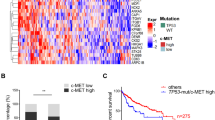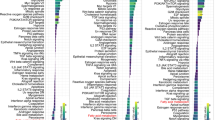Abstract
The hepatocellular carcinoma suppressor 1 (HCCS1) gene was identified by both positional cloning from a predominant region of loss of heterozygosity (17p13.3) in liver cancer and by functional screening for genes affecting cell proliferation in large-scale transfection assays. Its overexpression results in inhibition of cell proliferation in cell culture and tumor growth in nude mice. To understand its transcription regulation, the promoter architecture has been dissected in detail. The major start of transcription was mapped by primer extension to a C residue, 177 nucleotides upstream of the ATG codon. By assessing the promoter activity of a set of linker-scanning mutants of the minimal promoter (−60 to +148 region) in a transient transfection assay, we found that the +1 to + 40 region is critical to HCCS1 gene transcription, containing binding sites for transcription factors NF-κB (−21 to +7 and +40 to +26), p53 (+29 to +9) and ETS (+4 to +20 and +23 to +39). Biochemical and molecular analyses revealed that the ETS transcription factors ETS-2 and Elf-1 bind to the two ETS sites in situ and contribute significantly to the transcriptionally active state of the HCCS1 gene, while NF-κB, p53 and two other members of the ETS family (ETS-1 and NERF2) appear to play little role. Our observations provide insight into the mechanistic aspects of HCCS1 transcription regulation.
Similar content being viewed by others
Log in or create a free account to read this content
Gain free access to this article, as well as selected content from this journal and more on nature.com
or
References
Block TM, Mehta AS, Fimmel CJ, Jordan R . Molecular viral oncology of hepatocellular carcinoma. Oncogene 2003; 22:5093–5107.
Coleman WB . Mechanisms of human hepatocarcinogenesis. Curr Mol Med 2003; 3:573–588.
Zhao X, Li J, He Y, et al. A novel growth suppressor gene on chromosome 17p13.3 with a high frequency of mutation in human hepatocellular carcinoma. Cancer Res 2001; 61:7383–7387.
Wan D, Gong Y, Qin W, et al. Large-scale cDNA transfection screening for genes related to cancer development and progression. Proc Natl Acad Sci USA 2004; 101:15724–15729.
Xiao W, Park CK, Park JY, et al. Genetic alterations of the HCCS1 gene in Korean hepatocellular carcinoma. Apmis 2003; 111:465–473.
Boeger H, Bushnell DA, Davis R, et al. Structural basis of eukaryotic gene transcription. FEBS Lett 2005; 579:899–903.
Ercan S, Carrozza MJ, Workman JL . Global nucleosome distribution and the regulation of transcription in yeast. Genome Biol 2004; 5:243.
Neely KE, Workman JL . The complexity of chromatin remodeling and its links to cancer. Biochim Biophys Acta 2002; 1603:19–29.
Christensen RA, Fujikawa K, Madore R, Oettgen P, Varticovski L . NERF2, a member of the Ets family of transcription factors, is increased in response to hypoxia and angiopoietin-1: a potential mechanism for Tie2 regulation during hypoxia. J Cell Biochem 2002; 85:505–515.
Hoffman WH, Biade S, Zilfou JT, Chen J, Murphy M . Transcriptional repression of the anti-apoptotic survivin gene by wild type p53. J Biol Chem 2002; 277:3247–3257.
Zhu J, Gao B, Zhao J, Balmain A . Targeting gene expression to tumor cells with loss of wild-type p53 function. Cancer Gene Ther 2000; 7:4–12.
Xu J, Zhu J, Ni M, Wan D, Gu JR . The ATF/CREB site is the key element for transcription of the human RNA methyltransferase like 1(RNMTL1) gene, a newly discovered 17p13.3 gene. Cell Res 2002; 12:177–197.
Kielbasa SM, Gonze D, Herzel H . Measuring similarities between transcription factor binding sites. BMC Bioinformatics 2005; 6:237.
Kastan MB, Zhan Q, el-Deiry WS, et al. A mammalian cell cycle checkpoint pathway utilizing p53 and GADD45 is defective in ataxia-telangiectasia. Cell 1992; 71:587–597.
Harris SL, Levine AJ . The p53 pathway: positive and negative feedback loops. Oncogene 2005; 24:2899–2908.
Cai L, Zhu JD . The tumor-selective over-expression of the human Hsp70 gene is attributed to the aberrant controls at both initiation and elongation levels of transcription. Cell Res 2003; 13:93–109.
Modugno M, Tagliabue E, Ardini E, et al. p53-dependent downregulation of metastasis-associated laminin receptor. Oncogene 2002; 21:7478–7487.
Conibear E, Stevens TH . Vps52p, Vps53p, and Vps54p form a novel multisubunit complex required for protein sorting at the yeast late Golgi. Mol Biol Cell 2000; 11:305–323.
Oikawa T, Yamada T . Molecular biology of the Ets family of transcription factors. Gene 2003; 303:11–34.
Sharrocks AD . The ETS-domain transcription factor family. Nat Rev Mol Cell Biol 2001; 2:827–837.
Gilliland DG . The diverse role of the ETS family of transcription factors in cancer. Clin Cancer Res 2001; 7:451–453.
Seth A, Watson DK . ETS transcription factors and their emerging roles in human cancer. Eur J Cancer 2005; 41:2462–2478.
John S, Marais R, Child R, Light Y, Leonard WJ . Importance of low affinity Elf-1 sites in the regulation of lymphoid-specific inducible gene expression. J Exp Med 1996; 183:743–750.
Barton K, Muthusamy N, Fischer C, et al. The Ets-1 transcription factor is required for the development of natural killer cells in mice. Immunity 1998; 9:555–563.
Baker KM, Wei G, Schaffner AE, Ostrowski MC . Ets-2 and components of mammalian SWI/SNF form a repressor complex that negatively regulates the BRCA1 promoter. J Biol Chem 2003; 278:17876–17884.
Kang AD, Park G, Kim YH, Oh IH . Differential modulation of Myb family genes by Ets-2. Oncogene 2004; 23:4177–4181.
Yamamoto H, Flannery ML, Kupriyanov S, et al. Defective trophoblast function in mice with a targeted mutation of Ets2. Genes Dev 1998; 12:1315–1326.
Fisher RJ, Koizumi S, Kondoh A, et al. Human ETS1 oncoprotein. Purification, isoforms, -SH modification, and DNA sequence-specific binding. J Biol Chem 1992; 267:17957–17965.
Sapru MK, Florance SK, Kirk C, Goldman D . Identification of a neuregulin and protein-tyrosine phosphatase response element in the nicotinic acetylcholine receptor epsilon subunit gene: regulatory role of an Rts transcription factor. Proc Natl Acad Sci USA 1998; 95:1289–1294.
Li R, Pei H, Watson DK . Regulation of Ets function by protein-protein interactions. Oncogene 2000; 19:6514–6523.
Yordy JS, Muise-Helmericks RC . Signal transduction and the Ets family of transcription factors. Oncogene 2000; 19:6503–6513.
Lu X . p53: a heavily dictated dictator of life and death. Curr Opin Genet Dev 2005; 15:27–33.
Vousden KH, Lu X . Live or let die: the cell's response to p53. Nat Rev Cancer 2002; 2:594–604.
Aggarwal BB . Nuclear factor-kappaB: the enemy within. Cancer Cell 2004; 6:203–208.
Balkwill F, Coussens LM . Cancer: an inflammatory link. Nature 2004; 431:405–406.
Clevers H . At the crossroads of inflammation and cancer. Cell 2004; 118:671–674.
Luo JL, Maeda S, Hsu LC, Yagita H, Karin M . Inhibition of NF-kappaB in cancer cells converts inflammation-induced tumor growth mediated by TNFalpha to TRAIL-mediated tumor regression. Cancer Cell 2004; 6:297–305.
Acknowledgements
Thanks are due to Y Shi and W Heniig for their comments on this manuscript, as well as H Ji and N Rice for their kind provision of constructs. This work was supported by grants to Jing De Zhu from the Shanghai Science Foundation (04DZ14006 and 05DZ19318), the National Science Foundation (30450001, 30570850 and 10574134) and the National Research Program for Basic Research of China (2004CB518804 and 2002CB713700).
Author information
Authors and Affiliations
Corresponding author
Rights and permissions
About this article
Cite this article
Zhu, J., Fei, Q., Wang, P. et al. Transcription of the putative tumor suppressor gene HCCS1 requires binding of ETS-2 to its consensus near the transcription start site. Cell Res 16, 780–796 (2006). https://doi.org/10.1038/sj.cr.7310092
Received:
Revised:
Accepted:
Published:
Issue date:
DOI: https://doi.org/10.1038/sj.cr.7310092



